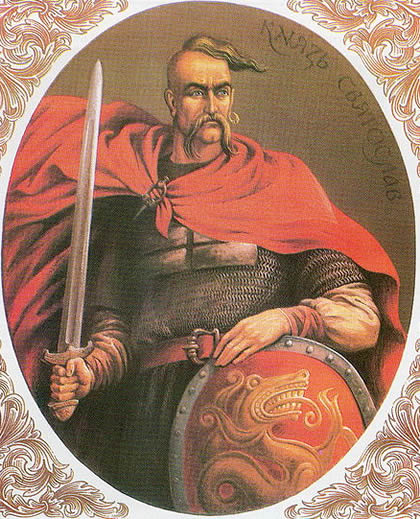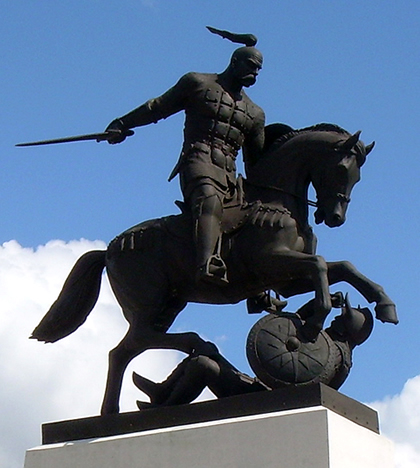 |
| Sviatoslav - King of Russia |
Sviatoslav ruled over the Rus with the capital in Kiev c. 969–972. He was the son of Kiev’s Prince Igor (r. 912–945) and Princess Olga (who ruled as Sviatoslav’s regent in 945–969 after Igor’s death), known in history as the fi rst Christian princess of Rus.
In historical literature Sviatoslav is often called the last Viking, the main goal of whose rule was the permanent and sometimes senseless war campaigns against the neighbors of Rus.
Olga’s 25-year rule resulted in Sviatoslav’s disinterest in internal state affairs, so he found a new field of activity—war campaigns in remote territories. The formal beginning of Sviatoslav’s rule is dated at 964 (his first war campaign), but in fact he only minimally influenced Kievan life until Olga’s death in 969.
  |
In spite of the influence of his tutor Asmoud and the military governor (voyevoda) Sveneld, he neglected Kiev and felt himself free from any obligations toward its population. He even announced his desire to live in another city, founded by him in Pereyaslav-on-Danube.
As prominent Ukrainian historians Olexiy and Petro Tolochko state, Sviatoslav’s mode of life was motivated exclusively by searches for battle and by mercantile gains from the campaigns often financed by Byzantine diplomacy. Sviatoslav’s campaigns reached into the east. In 964–966 Sviatoslav was at war with the Khazars for power of the Vyatichi Slavonic tribe.
 |
| Sviatoslav campaign |
This campaign resulted in the crushing defeat of the Khazar kaganat (princedom) and destruction of its capital Itil and the fortresses of Sarkel and Semender. At the same time he defeated the Volga Bolgars and took their capital Bolgar.
In the northern Caucasus he displayed himself in his victory over tribes of Yasy and Kasogi. Soon Volyn and the Carpathian regions had entered into the sphere of Sviatoslav’s attention, and his first squads were sent there, marking the beginnings of this region’s exploration, finished by his sons.
The most striking demam isu of Sviatoslav’s wars is connected with the Danubian or Balkan region. In 967 Byzantine emperor Nikephoros II promised Sviatoslav 455 kilos of gold for his campaign.
Most researchers believe that Sviatoslav also had his own interests there, so in August 968, his fleet with 60,000 troops gained victory over Bulgarian king Peter and gained control over 80 settlements on the Danube.
This campaign was interrupted by the Pecheneg siege of Kiev (968). Destruction of the Khazar princedom by Sviatoslav eliminated obstacles for their penetration into the inner Rus lands. The consequences of his war campaign caused the deep dissatisfaction of the local population.
This did not worry the prince, since he was planning to transfer his capital to Bulgarian lands, and soon after Olga’s death Sviatoslav started the second Balkan campaign (autumn 969), having sectioned control over major Rus lands among his three sons.
 |
| Sviatoslav statue |
His successes in 970 and tendency to conduct independent policy in the Danubian region forced the Byzantine emperor to start his expulsion, and the spring of 971 was marked by the taking of the Bulgarian capital of Preslav (the contemporary location is unknown).
Sviatoslav was in a two-month siege in Dorostol (modern Silistra), which resulted in a bloody battle and subsequent treaty with Byzantium (972), which Sviatoslav refused because of his claims on Crimea.
He went home with his army. On his way near the Dnipro Rapids he was met by Pechenegs, informed by the Byzantines about his trip, which weakened his forces in numerous battles. Trying to break through the nomads, Sviatoslav died in the early spring of 972.
EmoticonEmoticon